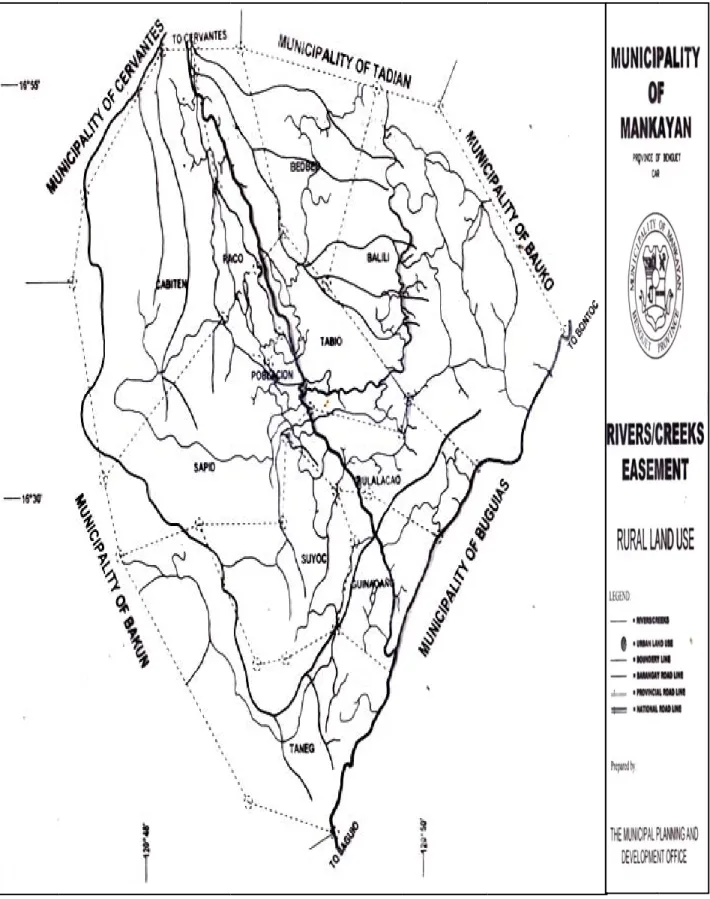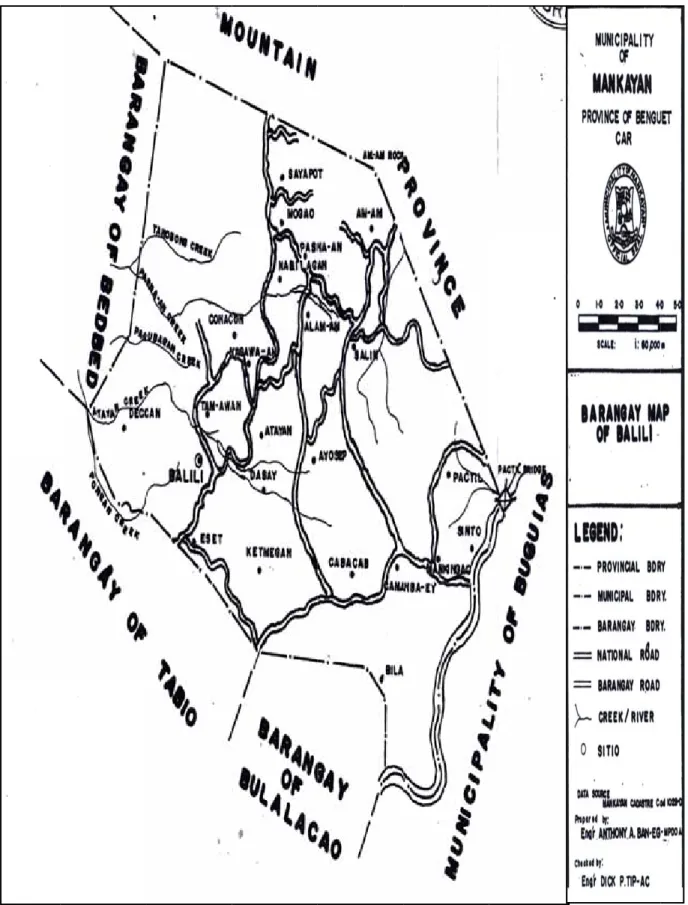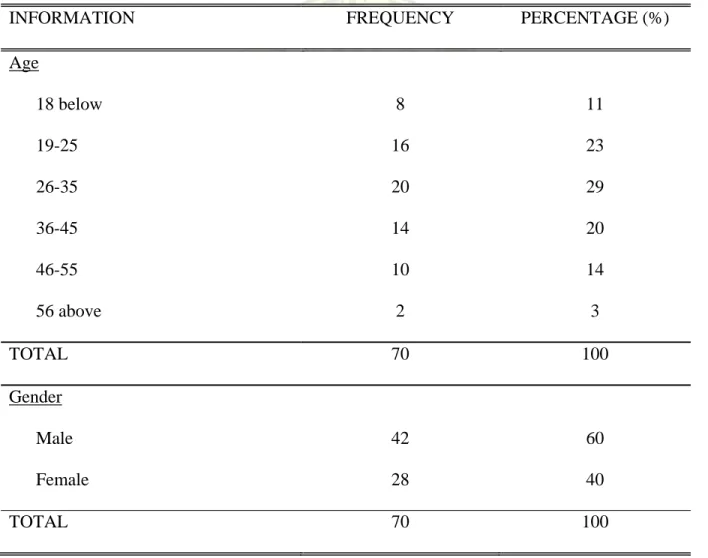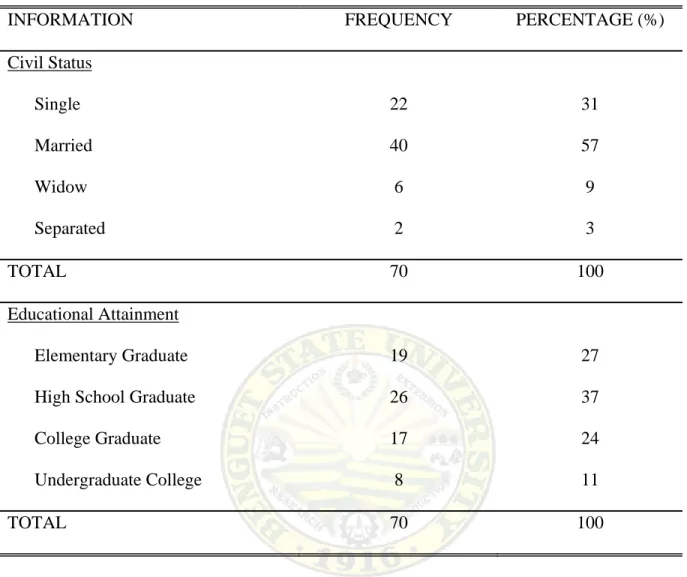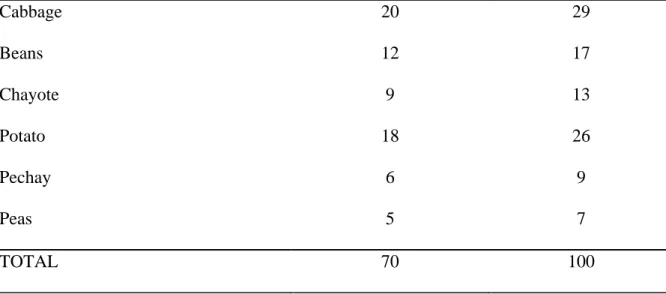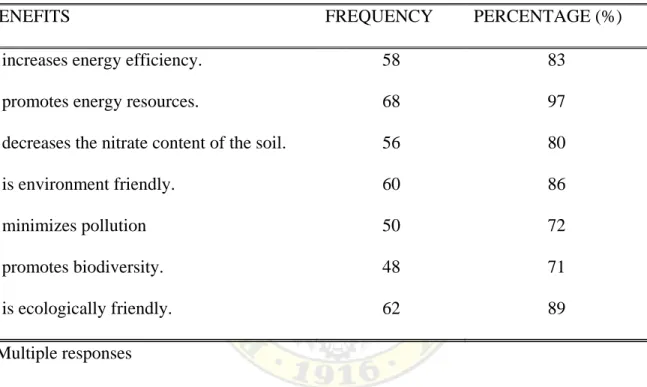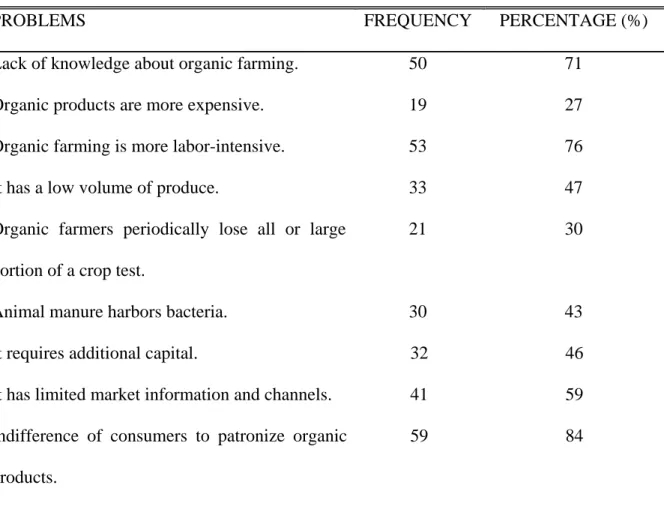COLAS, ROMEO JR. D. APRIL 2011. Perception of Farmers on Organic Farming in Balili, Mankayan, Benguet. Benguet State University, La Trinidad, Benguet.
Adviser: Hilario C. Perez, MSc.
ABSTRACT
This study was conducted to determine the socio-economic profile of the respondents, determine the socio-economic benefits of organic farming, and to find out the problems encountered in practicing organic farming.
A total of 70 vegetable farmers from Balili were the respondents. Most of the respondents were middle aged, married, and finished secondary education. The most common vegetable crops produced were cabbage and potato. The products are sold in the local market supplying the bulk of vegetables in the town proper where most of population in the municipality reside. They are the providers of vegetables in Lepanto which is a mining area in the locality thus marketability is not a grave problem. The other products are for their personal and family consumption.
Majority of the respondents agreed that organic farming offers socio-economic benefits.
Such benefits include environment benefits, marketing benefits, economic benefits and health benefits.
The most common problem that they may encounter in practicing organic farming is indifference of people to patronize organic products, it is labor intensive and they lack knowledge about organic farming.
Page
Bibliography……… i
Abstract………... i
Table of Contents……… ii
INTRODUCTION……….. 1
Rationale………..……… 1
Statement of the Problem……… 2
Objectives of the Study……….………. 3
Importance of the Study……….. 3
Scope and Limitation………..……….. 3
REVIEW OF LITERATURE………. 4
Description……….. 4
Organic Farmers……….. 5
Significance of Organic Farming in the Environment……… 5
Organic Farming Goes Global……… 6
Profitability of Organic Farming……… 7
Problems in Organic Farming……… 8
METHODOLOGY……….. 10
Locale of the Study………. 10
Respondents of the Study………... 10
Data Collection………... 10
Data Collected………. 13
RESULTS AND DISCUSSION………. 14
SUMMARY, CONCLUSIONS, AND RECOMMENDATION……….. 22
Summary……….. 22
Conclusion……… 23
Recommendation………. 23
LITERATURE CITED………. 24
APPENDIX……….. 25
A. Letter to the Barangay Captain……….. 25
B. Survey Questionnaire………. 26
INTRODUCTION
Rationale
Agriculture has been the main source of man’s daily needs. It is the key that led to the rise of civilization. It has played an important role in the lives of people. As the years past, changes and development have been made in order to increase the proficiency of produce.
Synthetic farm materials are being used just to provide enough production and to be able to generate more income. However, these have been causing damages on the environment as well as to man’s health. Because of these organic farming has been promoted in the community.
Organic farming began in the 1930s and 1940s as a reaction to agriculture’s growing reliance on synthetic fertilizers. These synthetic fertilizers were cheap, powerful, and easy to transport in bulk. Similar advances occurred in chemical pesticides in the 1940s leading to the decade being referred to as the “Pesticide Era”. Organic farming has remained tiny since its beginning. As environmental awareness and concern increased in the general population, the originally supply-driven movement became demand-driven. Premium prices from consumers and in some cases government subsidies attracted many farmers into converting. In the developing world, many farmers use the traditional methods which are comparable to organic farming but are not certified. In other cases, farmers in the developing world have converted out of necessity.
As a proportion of total global agricultural output, organic output remains small, but it has been growing rapidly in many countries (Wikipedia Encyclopedia, 2007).
Organic farming is still on the process of recruiting its practitioners. Many farmers still stick to what they had been doing for the past. Some are afraid to take the risk of switching to organic farming. This situation is also the same with the consumers. Consumers do not patronize
organically grown commodities because of its high cost. It is a little expensive compared to those produce though synthetic materials.
In Benguet, Benguet State University held the Organic Agriculture Congress to encourage farmers to switch to organic agriculture. Benguet farmers have already established a group called the La Trinidad Organic Producers or the LaTOP. This association aims to help each other in terms of technology, marketing and standardization of organically grown products.
They are pursuing its standardization project for its members to have a common understanding of organic farming and standardized practice and techniques, according to Jefferson Laruan, LaTOP general manager. He oversees the marketing of members’ produce and the implementation of their certification process for members and farmers who want to become members. LaTOP certification follows a rigid process of annual inspection, soil tests, technology practices and other parameters
(BSU News, 2006).
Statement of the Problem
Organic agriculture had been introduced in the community. Each one had different perception about it. Thus, these questions arose.
1. What is the Socio economic profile of the respondents?
2. What are the Socio economic benefits of organic farming?
3. What are the problems that may arise in practicing organic farming?
Objectives of the Study
This study aimed to determine the perception of farmers on Organic Farming. It specifically aimed to:
1. Determine the Socio economic profile of the respondents;
2. Identify the Socio economic benefits of organic farming; and
3. Determine the problems that may arise in practicing organic farming.
Importance of the Study
This study will be a basis to assist farmers in deciding to practice organic farming. This will help them assess the socio-economic benefits of organic farming. They can be able to have a little background of what is in the minds of other people when they hear about organic farming.
Furthermore, this study will become a basis or a reference for the conduct of further studies on organic farming.
Scope and Limitation
The study focused on the perception of farmers on organic farming in Balili, Mankayan, Benguet. Moreover it also included the socio-economic profile of the respondents, socio- economic benefits of organic farming as well as the problems encountered on organic farming.
The study was conducted in Barangay Balili, Mankayan, Benguet on December to January 2011.
The respondents were limited to farmers who were involved in vegetable production for at least one (1) year.
REVIEW OF LITERATURE
This chapter presents the different related studies and professional literatures closely related to this study.
Various concepts, points of view and opinions of authors on the different phases of evaluation are very helpful to the researchers in the analysis of problems.
Description
Organic Agriculture is the traditional term used by the farmers to capsulize the diverse farming system which avoided the use of synthetic chemical inputs (Briones, 1997). Many farmers misunderstood the real meaning of organic farming. Some say that it is the use of organic manure. It may be a part of organic farming but is not what really is.
Organic Farming blends indigenous principles of ecology and the science of conserving resources and building up productivity without using chemical pollutants (Domingo and Javier, 2000). Organic farming depends on appropriate crop rotations, green manuring, recycling of farm manure, and other ecological ways of building up soil fertility and productivity. Even pest control is done by applying non-chemical methods. It intentionally seeks sound conservation and quality enhancement of the soil, water, air and genetic resources through the scientific method (Domingo and Javier, 2000).
Organic Farming is synonymous to sustainable Agriculture. They are both promoting self-sufficiency and food security in crops (Rola, 2000).
Organic Farming is most relevant to small sized farms. Peligrina (1992) conducted a case study on the farm and income of Mr. Mamerto Fantilanan’s farm which 0.5 ha and founded that the farm earns more than it should earn. Its expenses only ranges from P30 to P6,270 but his income ranges from P180 to P35, 741 beginning from January to June 1990. This statistics show that organic farming is a very profitable choice of farming system
regardless of the farm size whether it is big or small.
Organic Farmers
The organic farmers have proven to the world that their farming system is distinguishable from other agricultural systems. It is competitive and provides products of good quality (Domingo and Javier, 2000).
Domingo and Javier mentioned that organic producers provide ecological services to society. These producers aim to promote the soil quality and conserve the soil. They are only ones really value the soil. They knew that without the soil, the farmer is useless. That is the reason why they had chosen to be organic producers. They are seen providers of
ecological services to society and their movement is recognized as grassroots movement.
Significance of Organic Farming in the Environment
There are many benefits to the environment that are derived from practicing Organic Farming. Its effect can be chronic or immediate. Scientific evidences show that even low levels of exposure to pesticides can cause serious immune and metabolic disorders, neurologic defects, reproductive anomalies, cancer and other chronic diseases in animals and in humans (Quijano, 2000). Organic Farming causes less pesticide contamination in food, people and the environment.
Organic Farming Goes Global
Organic farming has been an industry that campaigns for environmental regeneration around the globe. Seen as provider ecological services, consumers patronize the industry. People become concern about food quality and the environment. This paved the way for farmers to try organic farming. In Europe, the government provided large budget allocation for organic farmers to do research and development projects which aim to increase their production by 40% (Dodd,
1995). In the U.S., organic farming became practically a farmer’s movement. They have minimal support from the R and D but consumers patronize their products.
Asian countries had dominated the export of organic farming products in the world. Some Asian countries are considered as sources of organic raw materials. In China, the Organic Food Development Center (OFDC) and the Chinese National Chapter of the U.S. Organic Crop Improvement Association (OCIA) they have 10,000 certified organic farmers and 10 processors.
Most of their organic farms are in remote areas where agrochemicals have not been use. Some of the farms that had to be converted applied only minimal inputs of farm chemicals. Only few farms near urban centers were certified (Domingo and Javier, 2000). Korea has a Korea Organic Farmers Association (KOFA). This association aims to promote research and development on Organic Agriculture (Jung, 1997). In Benguet, Benguet farmers have already established a group called the La Trinidad Organic Producers or the LaTOP. This association aims to help each other in terms of technology, marketing and standardization of organically grown products.
They are pursuing its standardization project for its members to have a common understanding of organic farming and standardized practice and techniques, according to Jefferson Laruan, LaTOP general manager. He oversees the marketing of members’ produce and the implementation of their certification process fir members and farmers who want to become members (BSU
News, 2006).
Profitability of Organic Farming
Organic farmers have to do more than merely farm, following organic principles, in order to be successful financially. It is also important to know how to market their own produce. They must know how to do marketing and processing of these organic products. Some famers may sell directly to the consumers, some may use intermediate channels and others may use a
combination of methods. Some may decide to sell their raw produce whilst others may choose to process the product themselves. The farmer should know also to be more clout when negotiating with powerful buyers, suppliers or traders, and will have to complete with other players already in the established market. It is important to bear in mind throughout that success needs to be analyzed as failure, so that it may replicate in a variety of circumstances (Newton, 2004).
Large supermarket chains, food processors and manufacturers have become involved in organics. These outlets provide good publicity, as well as new outlets and distribution networks, but they also present new competition, by producing and marketing their own organic range.
Organic supermarkets have been set up in the United States, stocking not only organic products but also natural health and special dietary products. Organic farm products are charged with the reasonable price. In USA, organic vegetables, organic milk, and organic baby food all exhibited high price (Dimitri and Green, 2002).
Concerns facing organic producers are in the area of production such as inputs, yield, and total production as well as marketing such as product prices, cost of marketing, and market availability. The production problems of farmers were given emphasis and researches relating to soil, pests, and diseases. In the international trade of organic
products, the importance related issues has come to the fore (Wynen, 2002).
Problems in Organic Farming
Many organic farmers encounter technical, economic and social problems. One of these problems includes the maintenance of soil fertility and avoidance of pest attacks. Another problem encountered is that some farmers lack knowledge about organic management methods or inputs. Some inputs may be more expensive due to extra transport and handling changes (Wynen, 1992). More labor is also needed since organic farming is not an easy process but
requires vast steps to follow. Organic farms may require additional capital if the farmer has switched from conventional to organic. He should change his farm lay-out, storage, etc. some organic farmers also have the problem of having consumers patronize organic products.
According to Cooke consumers have the hard time to choose to buy organic products because they are priced higher than that of conventional farm products. In the output part, some farmers experience decreases in yield since there are constraints in nutrition and pest. The table below is a summary of the different problems or constraints experienced by the Organic Farmers in the developing countries (Twarog and Vossenar, 2002).
There are some of the constraints that are now encountered in developing countries. In relation to organic farming this includes the lack of technical know-how due to the lack of agriculture workers in the field; lack of organic production inputs such as composting, biopesticides, biofertilizers; labor intensive; conversion method, with reduced yields, may be larger obstacle than in developed countries; infrastructure problems such as roads and storage facilities; limited market information and channels; and lack of acceptance by existing standards and certification, or the need to import certification expertise in order to be able to export.
METHODOLOGY
Locale and Time of the Study
The study was conducted in Balili, Mankayan, Benguet Figure 1. The study included all sitios of the Barangay Balili, Mankayan. These sitios were Eset, Ketmegan, Dasay, Cabacab, Ayosep, Atayan, Balili Proper, Tam-awan, Deccan, Nagawa-an, Conacon, Bila, Camanba-ey, Mankingao, Sinto, Pactil, Salin, Alam-am, Am-am, Sayapot, Mogao, Pasna-an, and Nabilagan.
These sitios are shown in the map of Balili in Figure 2.
Balili is one of the twelve barangays of Mankayan. It is where most of its area is cultivated for agricultural purposes. Most of the farmlands in Mankayan are found in this barangay. Residents here depend in agriculture for their source of food and income.
The study was conducted in December 2010 to January 2011.
Respondents of the Study
The respondents were farmers who focused on vegetable production and were chosen through random sampling. This study considered 70 farmers which covered all
sitios of barangay Balili.
Data Collection
Data collection was done personally by the researcher. A survey questionnaire was administered to the respondents for them to answer. The questionnaire was composed of two parts namely the socio-demographic profile and the farmer’s perceptions. The questionnaire was coupled with an interview as well as ocular survey on the farms of the respondents.
Figure 1.. Map of Maankayan showwing the location of baraangay Balili
Figure 2.. Map of barrangay Balilii showing itss different sitios
Data Collected
The data that were gathered included the socio-demographic profile of the respondents and the perceptions of the respondents on Organic Farming.
Data Analysis
The data that were gathered were consolidated, compiled and tabulated. After which these were subjected to relevant statistical treatment, from which the results were used as basis for the analysis, interpretations, conclusions, and recommendations.
RESULTS AND DISCUSSION
Socio Economic Profile of the Respondents
Table 1 shows that majority (29%) of the respondents are 26 to 35 years old which is the middle age. Most of the respondents were males with an average of sixty percent (60%); females were only forty percent (40%). As to civil status, married respondents were of the most number with an average of fifty-seven percent (57%).
Majority (37%) of the respondents finished high school.
Table 1. Socio economic profile of the respondents
INFORMATION FREQUENCY PERCENTAGE (%)
Age
18 below 8 11
19-25 16 23
26-35 20 29
36-45 14 20
46-55 10 14
56 above 2 3
TOTAL 70 100
Gender
Male 42 60
Female 28 40
TOTAL 70 100
Table 1. Continued………..
INFORMATION FREQUENCY PERCENTAGE (%)
Civil Status
Single 22 31
Married 40 57
Widow 6 9
Separated 2 3
TOTAL 70 100
Educational Attainment
Elementary Graduate 19 27
High School Graduate 26 37
College Graduate 17 24
Undergraduate College 8 11
TOTAL 70 100
Vegetable crops produced by respondents. Table 2 shows the produced vegetable crops of the respondents, 29% cabbage; 26% potato; 17% beans; 13% chayote; 9% pechay; and 7%
peas. This implies that most of them plant crops that can be harvested in three to four months duration. In Balili, most farms are cultivated for family consumption only. They do not plant crops for mass consumption. This is the reason why most farmers plant short term growing crops. They plant crops which they could easily harvest in a short span of time.
Table 2. Vegetable crops produced by respondents
VEGETABLE CROPS PRODUCED FREQUENCY PERCENTAGE (%)
Cabbage 20 29
Beans 12 17
Chayote 9 13
Potato 18 26
Pechay 6 9
Peas 5 7
TOTAL 70 100
Socio economic benefits of organic farming
Table 3 shows the environmental benefits of organic farming. Based on the data gathered majority of the respondents agreed that organic farming has environmental benefits. This corroborates with Domingo and Javier (2000), citing that organic farming provides ecological services to the society. Ecological services derived include soil forming and conditioning, soil stabilization, waste recycling, carbon sequestration, nutrients cycling, predation, pollination and habitats. By opting for organic products, the consumer through his purchasing power promotes a less polluting agricultural system. It also promotes the soil quality and conserves the soil. This implies that organic farming is beneficial to the environment. Organic farmers are both custodians and users of biodiversity at all levels. At the gene level, traditional and adapted seeds and breeds are preferred for their greater resistance to diseases and their resilience to climatic stress.
Health benefits of organic farming. As shown in Table 4, most of the respondents agreed that organic farming provides health benefits. In relation to this, Quijano (2000) mentioned that organic farming causes less pesticide contamination in food, people and the
environment. Most of them claimed that organic farming provides healthier food.
Table 3. Environmental benefits of organic farming
BENEFITS FREQUENCY PERCENTAGE (%)
It increases energy efficiency. 58 83
It promotes energy resources. 68 97
It decreases the nitrate content of the soil. 56 80
It is environment friendly. 60 86
It minimizes pollution 50 72
It promotes biodiversity. 48 71
It is ecologically friendly. 62 89
*Multiple responses
Table 4. Health benefits of organic farming
BENEFITS FREQUENCY PERCENTAGE (%)
It reduces the risk of certain diseases. 60 86
It provides healthier food. 64 91
Organic products are free from chemical pesticides. 58 83
*Multiple responses
Economic benefits of organic farming. Table 5 shows the economic benefits of organic farming. Majority (61%) of the respondents agreed that organic farming reduced the cost of farm inputs since organic farming depends on green manuring and recycling of farm manure (Domingo and Javier, 2000). 54% of the respondents claimed that it is profitable; and 48% has great potentials for exportations. This coincides with Domingo and Javier (2000) who mentioned that Asian countries had dominated the export of organic products in the world. Lastly, 34%
provides employment since it is labor-intensive and requires vast steps to follow (Wynen, 1992).
Some of these steps include green manuring, building up soil fertility and others.
Price premiums for organic products are continuing to hold in most sectors. The demand for organic products is outpacing production, so there's plenty of room for growth. The economic benefits of organic production go deeper than that. By its nature, organic farming is a diversified production system. With a wider variety of products being grown, including livestock on some farms, the risks of market fluctuations and weather are
minimized. Dependence on costly outside inputs is dramatically reduced.
Table 5. Economic benefits of organic farming
BENEFITS FREQUENCY PERCENTAGE (%)
It reduces cost of farm inputs. 43 61
It has great potentials for exportation. 34 48 It provides employment since it is labor-intensive. 24 34
It is profitable. 38 54
*Multiple responses
Marketing benefits of organic farming. As shown in Table 6, most of the respondents (74%) said that it has a high price in the market; 64% said that it competes against conventional farm products; and 61% said that it paves the rise of an organic market. This implies that organic farming has the potential in the market. This corroborates with the study of Peligrina (1992) that organic farming earns more than it should earn.
Price premiums are important for the profitability of small organic farmers. Farmers selling directly to consumers at farmers' markets have continued to achieve these higher returns.
In the United States the number of farmers' markets tripled from 1,755 in 1994 to 5,274 in 2009.
Domingo and Javier (2000) also mentioned that organic farming is competitive and provides products of good quality. Organic foods also can be a niche in developing nations. It would provide more money and a better opportunity to compete internationally with the huge distributors. Organic prices are much more stable than conventional foods, and the small farms can still compete and have similar prices with the much larger farms that
usually take all of the profits.
Table 6. Marketing benefits of organic farming
*M
ulti
ple
resp
onses
BENEFITS FREQUENCY PERCENTAGE (%)
It competes against conventional farm products. 45 64 It paves the rise of an organic market. 43 61
It has a high price in the market. 52 74
Problems encountered in practicing organic farming. As shown in Table 7, the number one problem encountered by most of the respondents is that the indifference of consumers to patronize organic farm products with 84%. This is because consumers have the hard time to choose to buy organic products since the price is higher compared to conventional farm products.
While the least encountered problem is that organic products are more expensive with 27%.
76% said that organic farming is labor-intensive. This
corroborates with Wynen (1992) citing that organic farming requires vast steps to follow.
Table 7. Problems encountered in practicing organic farming
*Multiple responses
PROBLEMS FREQUENCY PERCENTAGE (%)
Lack of knowledge about organic farming. 50 71
Organic products are more expensive. 19 27
Organic farming is more labor-intensive. 53 76
It has a low volume of produce. 33 47
Organic farmers periodically lose all or large portion of a crop test.
21 30
Animal manure harbors bacteria. 30 43
It requires additional capital. 32 46
It has limited market information and channels. 41 59 Indifference of consumers to patronize organic
products.
59 84
71% said that they lack knowledge about organic farming; 59% said that they have limited market information and channels; 47% said that they have low volume of produced; and 46%
said that it requires additional capital. In relation to this, Wynen (1992) mentioned that organic farming requires changes in farm lay-out and storage. 43% said that animal manure harbors bacteria; and 30% claimed that they lose all or largely portion of a crop test.
SUMMMARY, CONCLUSIONS AND RECOMMENDATIONS
Summary
The study on the perception of farmers on organic farming in Balili, Mankayan, Benguet was conducted to determine the socio-economic profile of the respondents, identify the socio-economic effects of organic farming, and to determine the problems that may arise in practicing organic farming as perceived and observed by the farmers.
Results of the study showed that respondents are middle age, mostly were males, married and finished secondary education. The major vegetable crops produced were cabbage and potato.
Most of them claimed that the environmental benefit is that it promotes energy sources, it is environment friendly, and it reduces carbon dioxide production.
For the health benefits, they claimed that it provides healthier food, it is free from chemical pesticides and it reduces risk to certain diseases.
As to economic benefits, most of them claimed that it reduces cost of farm inputs, and is profitable.
In the marketing benefits, most of them claimed that it is easy to dispose, it is patronized by consumers, it competes with conventional produced vegetables and it paves the rise of an organic market.
The most common problem that they may encounter in practicing organic farming is indifference of people to patronize organic products, it is labor intensive and they lack knowledge about organic farming.
Conclusions
Based on the findings, the following conclusions are derived:
1. Most of the farmers are middle ages, mostly were males, married and finished secondary education. The major vegetable crops produced were cabbage and potato.
2. Organic farming has socio-economic benefits. These benefits include marketing, environment, health and economic benefits.
3. Certain problems are also encountered in practicing organic farming. This includes consumer patronization, capital, inputs, lack of knowledge and market channels.
Recommendations
Based on the conclusions, the following recommendations are derived.
1. The farmers of Balili, Mankayan, Benguet should undergo training, and seminar on Organic Farming.
2. Farmers should organize themselves into an organic farmer’s organization so that they may be able to help each other regarding their problems on organic farming.
3. The farmers should be encouraged to practice organic farming.
LITERATURE CITED
BRIONES, A. 1997. National Study: Philippines in Organic Agriculture and Rural Poverty Alleviation: Potential and Best Practices in Asia. NESCAP-Bangkok, Thailand. Pp.119- 145.
BSU-NEWS. 2006. Farmers, Government Institutions Unite to Promote Organic Farming in Cordillera.
DIMITRI, C. and C. GREEN. 2002. Recent growth patterns in the U.S. organic foods market.
ERS Agriculture Information Bulletin No. AIB777. September. Pp 42.
DODD, G. 1995. An agricultural revolution. In: Denmark Review/Business News from Denmark 3/95, Helweg-Larson, U. ed. Copenhagen.
DOMINGO, O.F. and T.R JAVIER. 2000. Sustainable Development through Organic Agriculture.
JUNG, J. Y. 1997. Organic agriculture in Korea. Paper submitted to IFOAM-Asia Board Meeting. 30 October, Hanoi, Vietnam.
KRISTIANSEN, P. 2006. Organic Agriculture: A Global Perspective. Pp. 7-18.
NEWTON, J. 2004. Profitable Organic Farming. Second Edition. Pp.121-131.
PELEGRINA, W. 1992. Sustainable Agriculture as Practiced by Farmers in the Philippines (Case Studies), SIBAT National Secretariat, Quezon City, May 1992.
QUIJANO, R. 2000. Health and Environment Hazards of Pesticide. Philippines.
ROLA, A. 2000. Research Program Planning for Agricultural Resource Management: A Background Analysis
TWAROG, S. AND R. VOSSENAR. 2002. Obstacles facing developing country exports of organic products.
WIKIPEDIA ENCYCLOPEDIA. 2007. Organic Agriculture. Retrieved from http//en.wikipedia.org/wiki/organic_agriculture,2009.
WYNEN, E. 1992. Conversion to Organic Agriculture in Australia: Problems and Possibilities in the Cereal-Livestock Industry. National Association for Sustainable Agriculture, Australia. Sydney.
WYNEN, E. 2002. A UN convention on soil health or what are the alternatives.
APPENDICES
APPENDIX A
Letter to the Barangay Captain
BENGUET STATE UNIVERSITY College of Agriculture Department of Extension Education
28 January 2011
HON. PACITO K. DONATO Barangay Captain
Balili, Mankayan, Benguet
Sir:
I am Romeo Colas Jr., a graduating student of the Bachelor of Science of Agriculture major in Extension Education. I will be conducting my thesis titled, “PERCEPTION OF FARMERS ON ORGANIC FARMING IN BARANGAY BALILI, MANKAYAN, BENGUET.”
In this regard, I am asking your good office to please allow me to conduct and interview the residents as the respondents of the said project.
Rests assure that all the information that will be gathered will be deemed very confidential. Thank you very much and hope for a positive response.
Truly yours,
ROMEO COLAS JR.
Researcher
APPENDIX B Survey Questionnaire
I. SOCIO ECONOMIC PROFILE Kindly fill up the space below.
A. Personal Information
Respondents Name:
Gender: Male Female Date of Birth: / / Age:
Civil Status: Single Married
Separated Widow Educational Attainment:
Elementary Graduate High School Graduate College Graduate
Others: (specify)
Religion: Roman Catholic Couples for Christ
Anglican Baptist
UCCP Assembly of God
Inglesia ni Cristo Jehovah’s Witnesses
Others: (specify)
Number of Children:
Income per Month/Per Year:
B. Vegetable Products:
Cabbage Beans Peas Sayote
Chinese Cabbage Broccolli
Cauliflower Pechay
Others: (specify)
II. PERCEPTION OF FARMERS
A. Listed below are the Socio Economic Effects of Organic Farming. Please check (√) the box that corresponds to the effects you encountered in organic farming.
a. ENVIRONMENT
YES NO 1. It prevents pollution.
2. It increases energy efficiency.
3. It promotes energy resources.
4. It decreases the nitrate content of the soil.
5. It promotes biodiversity.
6. It is environment friendly.
7. It is ecologically friendly.
b. HEALTH
YES NO 1. It reduces the risk of certain diseases.
2. It provides healthier food.
3. Organic products are free from chemical pesticides.
c. ECONOMIC
YES NO 1. It reduces cost of farm inputs.
2. It has potentials for exportation.
3. It provides employment since it is labor-intensive.
4. It is profitable.
d. MARKET
YES NO 1. It has a high price in the market.
2. It paves the way for the rise of organic market.
3. It gives rise to demands of organic food in the market.
4. It is competes against conventional farm products.
B. Listed below are the problems encountered in practicing organic farming. Please check (√) the box that corresponds to the problems that you have encountered in organic farming.
YES NO 1. Lack of knowledge about organic farming.
2. Organic products are more expensive.
3. Organic farming is more labor-intensive.
4. It has a low volume of produce.
5. Organic farmers periodically lose all or a large portion of a crop to pests.
6. Organic animal manure harbors deadly bacteria.
7. It requires additional capital.
8. It has limited market information and channels.
9. Indifference of consumers to patronize organic products.
